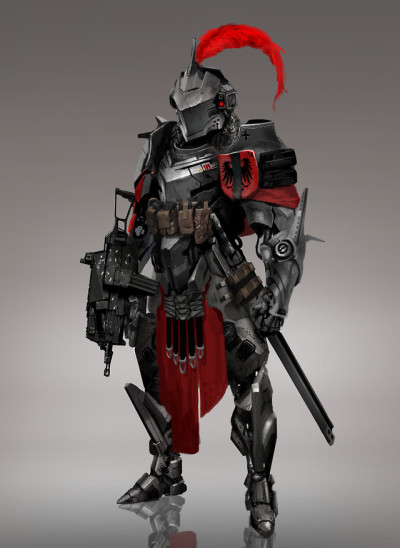8,500 Infantrymen

The common infantryman of the Royal Army is clad in combat armor and is likely issued the
C1A3 Rifle, itself a long-standing derivative of the classic FN FAL battle rifle. Those in more specialized roles are issued either the
C7 General-Purpose Machine Gun, the
C2 Marksman’s Rifle, or the
C3 Submachine Gun in 10mm Auto. In comparison to the average military force of the Wastes, the Royal Armyman is remarkably well-protected, if the average production quality of combat armor remains inferior to that of Pre-war manufacturing standards. The general-issue combat helmet is of a sturdy metal design, offering quite good protection against shrapnel and low-powered rounds, though soldiers often take to padding the insides with wool or cloth for their comfort. An additional ballistic mask is issued alongside their helmets, though its protectiveness comes at the expense of visibility, and is often not worn when soldiers are not in intense combat. Ammunition, grenades, and other pieces of the infantryman’s kit are held in bandoliers or belt pouches. As per the regime of a versatile fighting force, all infantrymen are trained in the use of bayonets, both attached and detached from their rifles, as a well-timed and well-supported bayonet charge will make quick work of ambushers and those who mistakenly believe the weakness of the Royal Army lay in close-quarters assault.
The Royal Infantry Corps is supported by artillery crews, employing quarter-pounder guns in the rear echelons of the military. As per tradition, the Royal Army is adjoined by a Morale Corps, where drummers beat to the marching pace, chansoners unite the infantry under cherubic battle hymns, and flag-bearers proudly proclaim the conquests of key objectives on the battlefield.
48 Main Battle Tanks

Stemming from the Pre-War Centurion tank, the Mk. 14 is the current iteration in service with the Royal Army. Reliable, versatile, and powerful, the scarcity and intensive production of the vehicle limits its use in common engagements. Used as a means to achieve a frontal breakthrough, MBTs are, much like their Pre-War ancestors, often used in tandem with infantry, air forces, and more mobile land forces in order to overwhelm the enemy at multiple angles.
1,500 Mechanized Infantry
Proliferating from the need of the military for rapid-moving infantry forces, the Mechanized Infantry operate either with the
Boudicca-78/S or the
Crerar M6 Scout Car. As the use of energy cells to power the vehicles in question stems from conscious recycling efforts, while the Mechanized Infantry may certainly be a quick and well-organized force, but are in danger of overextending themselves through too hasty a chase, or overextending their supply range. As such, more often than not, Mechanized Infantry work in-tandem to the standard infantry, where they serve as a breakthrough or flanking force to scatter enemy forces.
1,400 Alpinist Corps
The Imperial Alpinists consist of rangers and pathfinders used to operating in treacherous terrain. Through rigorous, specialized training, the Alpinist Corps are capable of operating without supply for weeks on end, and often serve as the “eyes and ears” in front of the main army. Specialized in sabotage, reconnaissance, deep battle, and search and rescue operations, each Alpinist carries with them the
C5 Assault Rifle, utilizing the lightweight, high-velocity 5mm round. In addition, survival and mountain-climbing equipment is apart of their standard armament.
400 Airborne
A recent addition to the Royal Army, recent analyses of battle tactics have begged the question to utilize paratroopers. While the forces are still in the experimental phase of doctrinal development, early field exercises show great promise in the expertise of elite troops that can - in tandem with the other Imperial Armed Forces - wreak havoc behind enemy lines to cut off supply or retreat routes. Much like their Alpinist cousins, Airborne troops are issued the
C5 Assault Rifle chambered in 5mm, allowing for a stunning amount of ammunition to be carried at such a light weight.
5,500 Gendarmerie

Acting as a mixture of military police force and scouting corps, the Royal Gendarmerie are the eyes and ears of the ground forces. Atop horses, the Gendarmerie guardsman is often more lightly-armed than the infantryman, but what they gain in return is mobility far surpassing many of the things that might gait the Wastes.
A few particularly daring souls among the Gendarmerie have made attempts to domesticate Yao Guai for use as more ferocious mounts, but their success has been...dubious, at best.
400 Knights

Clad in carefully-maintained power armor, Imperial Knights are the finest shock troopers the Imperial Armed Forces have to offer. As the manufacture - or more likely, scavenging - of new power armor suits is an excruciatingly sluggish process, nearly every single suit of power armor in service is unique. Few suits bear semblance to their originals, and have had plates, rivets, and exoskeletons repaired and replaced over the centuries these antediluvian suits have been in employ. Resulting from such processes, each suit of Imperial Power Armor is often heavily customized, adorned in an assortment of charms, insignia, and trophies.
The armaments of the Knights is no less impressive than their ancient armor, often using the only energy weapons to be found in the entirety of the Empire. Many Knights commonly utilize heavy weapons, such as miniguns, missile launchers, or machine guns.
Only the most hardened, cunning, or connected of soldiers are given the opportunity to become Knights, for the “opening” of a suit of power armor itself is an equally sporadic event. A majority of Imperial Knights are already veterans of a multitude of campaigns, the power armor only auxilarating their potent skill as they fearlessly smash apart enemy lines.




